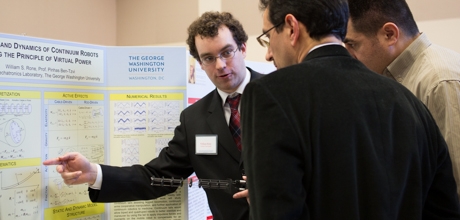With topics like the foundations of nanoscience and an environmentally friendly type of magnetic refrigeration system, seven George Washington graduate students and two undergraduates captured $18,000 in prize money during the seventh annual School of Engineering and Applied Science Student Research and Development Showcase, held on Feb. 20 in the Marvin Center’s Grand Ballroom.
The $5,000 first-place prize went to Jiaoyan Li, a student in the Department of Mechanical and Aerospace Engineering, for her work developing a theoretical framework for nanotechnology that increases understanding about how to design and synthesize nanomaterials and where to apply nanotechnology. Her project—called “4M” for multiple length/time scale modeling of multiphysics for nano/micro material systems—was completed with Professor James D. Lee, her adviser.
“[Winning first prize] not only positively affirms our work, but also gives me more confidence for future success,” Ms. Li said.
The second place award, worth $4,000, went to Mohammadreza Ghahremani and Hatem El Bidweihy, of the Department of Electrical and Computer Engineering, for their exploration of an energy-efficient and environmentally friendly magnetic refrigeration system. Their advisers are Professors Edward Della Torre and Lawrence Bennett.
The third-place award of $3,000 went to Anastasia Wengrowski, a student in the Department of Electrical and Computer Engineering who worked with her adviser, Assistant Professor Matthew Kay, on changes in cardiac function in response to light-activated norepinephrine, a stress hormone.
The best undergraduate project award, worth $2,000, went to Elizabeth Hubler for her work with adviser Michael Plesniak, a professor in the Department of Mechanical and Aerospace Engineering, on evaluating synthetic models of the vocal folds.
A new prize for 2013—the entrepreneurship award, worth $2,000—was given for a project with great commercial potential. The award went to undergraduate students Yash Jain and William Murphy for their work on propagating a cold atmospheric plasma jet through an endoscopic tube. The students worked with adviser Michael Keidar, an associate professor in the Department of Mechanical and Aerospace Engineering.
When used at room temperature, plasma has the ability to kill cancer cells while leaving healthy cells untouched. Previously, this effect could only be induced externally. But Mr. Jain and Mr. Murphy’s work with an endoscopic tube means that the plasma treatment can be applied to internal forms of cancer.
“This is a new form of treatment that could possibly surpass the effectiveness of current methods and has garnered much interest,” Mr. Murphy said.
Four runner-up prizes of $500 were awarded as well, to graduate students Matthieu Andre, Benjamin Holmes and Marjan Nabili, and to undergraduate Christopher O'Brien. A complete list of winners and project titles is available on the SEAS website.
George Washington President Steven Knapp told the showcase participants and judges that SEAS is a vital part of the university’s overall success.
“The fact that we can bring so many talented students here at the undergraduate and graduate levels, to work on projects like I’ve seen this afternoon, is a great contribution to our nation,” he said. “This nation is only going to remain strong if we remain at the forefront of innovation. That’s what you have chosen to do as your life’s work. I congratulate you on the choice you’ve made.”
SEAS Dean David Dolling said the event is the culmination of months and sometimes years of work for the participants, entailing many moments of frustration punctuated by flashes of inspiration. Ultimately, they were learning one of the major truths of research, he said.
“Satisfaction only comes from taking on tough problems and solving them. Doing the easy stuff is not satisfying.”
GW’s Office of Technology Transfer had already filed seven provisional patents based on work exhibited at the R&D Showcase, a testament to the extraordinary quality of the students’ work, Dr. Dolling said.
The event’s keynote speaker was Charles Camarda, a GW alumnus and NASA astronaut. Dr. Camarda earned a master’s degree in engineering science from GW in 1980 and became a member of the astronaut corps in 1996. He has logged more than 300 hours in space.
Dr. Camarda spoke about creating a culture of innovation within an institution, with examples from his own work helping NASA review the Columbia shuttle tragedy in 2003. In that case, a piece of insulating foam broke off the shuttle during launch, leading to the shuttle’s disintegration upon reentry to the atmosphere. After this tragedy, NASA needed to change its culture, he said, to ensure that errors similar to the one that caused the Columbia disaster wouldn’t be allowed to happen again.
“Creativity is imagination applied,” he said, encouraging the students to be creative thinkers who are open to the idea of failure. “Fail early and often. It allows you to learn more … Intelligent, fast failure leads to better answers.”
SEAS would like to thank the sponsors of the 2013 Research and Development Showcase: RiVidium, the Bruce J. Heim Foundation, Goya, LinQuest, Hegarty Research LLC, iCes, Capital Construction Consultants, Inc., Turner, Siemens and media sponsor InTheCapital.


